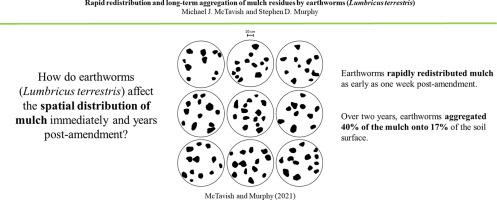Applied Soil Ecology ( IF 4.8 ) Pub Date : 2021-08-21 , DOI: 10.1016/j.apsoil.2021.104195 Michael J. McTavish 1, 2 , Stephen D. Murphy 1

|
There has been minimal study of how ecosystem engineering anecic earthworms such as Lumbricus terrestris L. may influence the distribution of mulch amendments across the soil surface by collecting residues into middens. The two primary research objectives of this study were: (1) to determine how rapidly earthworms change the surface distribution of mulch following amendment, and (2) to produce a more spatially explicit map of earthworm aggregation of mulch. This study used a microcosm experiment to assess the immediate, short-term impacts of earthworms on recently added mulch at a small scale, and an opportunistic field study of the longer-term impacts of earthworms on the distribution of corn ‘stubble’ mulch in a former agricultural field. In the microcosm experiment, earthworms rapidly redistributed mulch within the first week post amendment, decreasing initial ground cover (15-29% decrease). Over the subsequent five weeks, initial cover continued to decrease (20-45% decrease) as mulch was spread thinly onto adjacent, initially bare soil (49-69% increase). Higher mulch amendment mitigated losses in initial cover. In the field study, earthworms aggregated mulch across the soil surface, collecting 40% of the woody corn residues into 17% of the total area in regularly distributed middens. These results demonstrate the potential for L. terrestris to alter the distribution of mulch rapidly in the first several days and weeks following application and in the longer term over several years, increasing the spatial heterogeneity of soil resources. This physical redistribution has only been minimally investigated and may help inform models of earthworm impacts on various ecological processes and improve soil amendment and residue management in earthworm-occupied soils.
中文翻译:

蚯蚓(Lumbricus terrestris)对覆盖物残留物的快速重新分配和长期聚集
关于生态系统工程如何改造无毛蚯蚓(如Lumbricus terrestris)的研究很少L. 可能会通过将残留物收集到中间来影响整个土壤表面的覆盖物改良剂的分布。本研究的两个主要研究目标是:(1) 确定蚯蚓在修正后改变覆盖物表面分布的速度,以及 (2) 生成更空间明确的覆盖物蚯蚓聚集图。本研究使用微观实验来评估蚯蚓对最近添加的小规模覆盖物的直接短期影响,以及蚯蚓对玉米“茬”覆盖物分布的长期影响的机会主义实地研究以前的农田。在微观实验中,蚯蚓在修正后的第一周内迅速重新分配覆盖物,减少初始地面覆盖(减少 15-29%)。在接下来的五个星期里,随着覆盖物薄薄地铺在相邻的、最初裸露的土壤上(增加 49-69%),初始覆盖率继续减少(减少 20-45%)。更高的覆盖修正减轻了初始覆盖的损失。在田间研究中,蚯蚓在土壤表面聚集覆盖物,将 40% 的木本玉米残留物收集到 17% 的规则分布的沼泽地总面积中。这些结果证明了L. terrestris在施用后的最初几天和几周内迅速改变覆盖物的分布,并在几年内长期改变,增加土壤资源的空间异质性。这种物理再分布仅进行了最低限度的研究,可能有助于为蚯蚓对各种生态过程的影响模型提供信息,并改善蚯蚓占据土壤中的土壤改良和残留物管理。



























 京公网安备 11010802027423号
京公网安备 11010802027423号